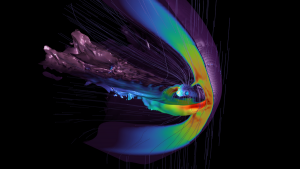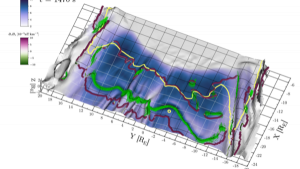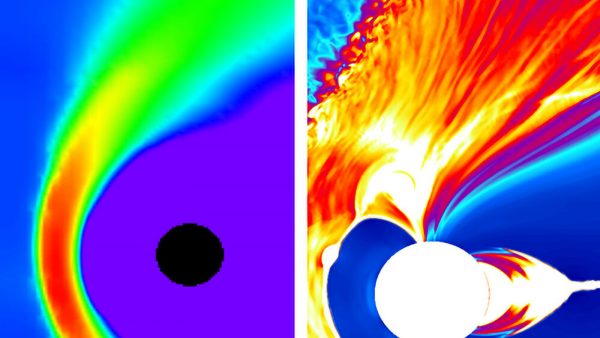Oct. 10, 2023 — With the development of reusable rockets and smaller, cheaper satellites, the space industry is booming. As a consequence, society is increasingly dependent on satellites for critical functions such as communication and navigation. Ensuring that satellites remain safe in space is thus not only a question of protecting investments, but also of ensuring that human life on Earth runs smoothly.

Unfortunately, however, scientists still do not have a satisfactory understanding of important phenomena in near-Earth space that affect satellite function. Dynamics in the solar wind as it approaches Earth, for example, can wreak havoc on orbiting satellites, and despite many decades of research it has been challenging to develop detailed models of such conditions. Obstacles include the fact that space is obviously much larger than anything found on Earth, space weather is physically more complex than terrestrial weather, and there are limits on the number of satellites that can be shot into space to gather observational data. In the future, scientists would like to be able to predict weather in space as well as they do on Earth. For this to be possible, though, simulation of space physics using supercomputers is needed now, as it offers the best available methods for investigating many open questions.
For more than 10 years, Dr. Minna Palmroth, a professor in the Space Physics Research Group at the University of Helsinki, has been leading the development of a model called Vlasiator that holds the potential to improve scientists’ understanding of the magnetosphere, the region surrounding Earth in which the planet’s electromagnetic field interacts with the solar wind. Using several generations of supercomputers at HLRS — Hermit, Hazel Hen, and now Hawk — she and her team have been improving Vlasiator’s capabilities so that it now provides a six-dimensional, global model of near-Earth space. In what she considers the culmination of her career so far, a recent publication in the journal Nature Geoscience demonstrates that Vlasiator can provide unique insights into phenomena that have been impossible to study using other simulation methods.
Vlasiator Reduces Approximation In Particle Modeling
Physicists have been using computers to simulate conditions in near-Earth space since the 1970s, but existing algorithms have had no choice but to approximate some of its most important features. In magnetohydrodynamics (MHD), an established approach for simulating the magnetosphere, codes contain a built-in assumption that particle velocities in space are distributed in the same way they are on Earth; that is, following a normal distribution. In the terrestrial world, many particles in a given 3-dimensional cube cluster around an average velocity, with a relatively small number of outliers having either a very low or very high velocity. Because temperature is the result of moving particles, this distribution gives a good representation of the temperature of the air in the cube.

One long-recognized problem in space physics is that proton velocities in space do not follow a normal distribution, but are much more variable. Accounting for protons’ actual behavior within MHD codes would require prohibitively large amounts of computing power, however. This means that modelers of space have had no choice but to treat particles in space in the same way as particles on Earth.
For Dr. Palmroth and her colleagues, improvements in algorithm development and the arrival of more powerful supercomputers like those at HLRS offer the opportunity to develop a model that doesn’t require this compromise. “Running Vlasiator at HLRS, we use a different approach that enables us to model all proton-related phenomena in near-Earth space as they are, based on fundamental physical principles, without the need to approximate,” she says.
To produce global simulations of the Earth’s magnetosphere and ionosphere, Vlasiator considers six different dimensions — three spatial dimensions plus three dimensions that quantify particle distributions. The code does not model the movement of individual particles, but rather provides a highly accurate representation of how proton distribution changes in space and time. (The mathematical approach they use is called the Vlasov equation.) “The shape of the particle distribution is crucial in many decades-old mysteries that haven’t been solved,” Palmroth explains. “By focusing on this issue, Vlasiator can reveal processes that haven’t been visible before.” This capability has made it possible for her team to open new windows for studying space physics.
Simulation Explains Earth Plasma Eruptions
One of the most unpredictable phenomena that takes place within the magnetosphere is called a substorm. Here, interactions between the solar wind and the Earth’s electromagnetic field lead to a buildup and sudden ejection of plasma called a plasmoid in the magnetotail, the part of the magnetosphere on Earth’s nighttime side. From Earth’s surface, these ejections are visible as especially spectacular auroras, but they can also damage satellites or interfere with their operation.
Although there have been attempts to explain substorms, their causes have been little understood. One potential explanation, called magnetic reconnection, suggests that changes in the electromagnetic field in the magnetotail sever part of the magnetosphere, which is released as a plasmoid. Another, called kinetic instability, posits that instabilities in the magnetotail produce waves that disrupt the current that sustains the magnetospheric tail, leading to plasmoid ejection.
Running Vlasiator on HLRS’s Hawk supercomputer, Palmroth and her team simulated the magnetosphere at a scale capable of revealing the physics underlying both of these hypotheses. Surprisingly, their results indicated that both magnetic reconnection and kinetic instabilities occur, but not in the way that space physicists understood them in the past. Their paper in Nature Geoscience reports that plasmoid ejection occurs when smaller plasmoids are unified into a large plasmoid as a result of disruption in the current, which is caused by a kinetic instability.

According to Palmroth, it is the global nature of Vlasiator that made these novel findings possible. “Vlasiator now includes the upstream solar wind, the magnetosphere, and the ionosphere,” she explains. ”Plasma phenomena occur at a much smaller scale, but because global features affect local features, and vice versa, you need a global model to provide the necessary context. Without the global model, it is impossible to understand the evolution of the whole system at the same time.”
Comparing Vlasiator’s results to available observational data, Palmroth has found that the results provide a detailed and accurate picture. The code enables them to observe other features of the magnetosphere as well. Additional recent papers have reported on discoveries regarding the transmission of foreshock waves through Earth’s bow shock, auroral proton precipitation, and the properties of Pc3 waves, for example.
Success Through a Long-Time Partnership with HLRS
Palmroth recalls that when she first proposed the idea of creating a global ion-kinetic model of the magnetosphere around 2004, many colleagues advised her that it would never be computationally practical. During Vlasiator’s development, however, she has always developed code not for the architectures and capabilities of current HPC systems, but for future, more powerful HPC technologies.
“This philosophy only works if we are in close collaboration with people who look at the technological future,” she explains. “This is why the High-Performance Computing Center Stuttgart is one of my favorite high-performance computing centers to work with. HLRS has an absolutely exquisite HPC knowledge and expertise, which is crucial when we are developing our algorithms. It enables a productive co-design process.”
In addition to opening new fields for studying space science, Vlasiator is also remarkable for its efficiency when running on HLRS’s Hawk supercomputer. Palmroth says that experts in computational modeling are often surprised at the code’s performance, as it scales almost linearly when running on up to 200,000 compute cores. Palmroth credits this achievement to close collaboration with HLRS’s user support staff, who have provided valuable advice on how to manage issues such as input-output, data storage, and other technical issues necessary for optimal usage of the center’s supercomputers. “HPC experts at HLRS set high standards in application performance that we strive to realize in practice,” she says.
As HPC approaches the exascale, Palmroth and her team see a number of opportunities for increasing Vlasiator’s capabilities. In the future, they anticipate being able to improve the resolution of their model, simulate longer periods of physical time, and do multiple runs of the same simulation to produce even better models based on comparative statistical analysis. Vlasiator was originally designed for supercomputers based on CPU processors, and so the team is also currently completing a rewrite of Vlasiator’s code so that its calculations of velocity space can run on GPU accelerators. Because the velocity calculations take up to 90% of the computing time, she estimates that this effort could enable the code to run at least 20 times faster.
Such plans suggest that as high-performance computing continues to evolve, the Palmroth Lab will continue deliver new insights about the neighborhood surrounding our planetary home.
Source: Christopher Williams, High-Performance Computing Center Stuttgart (HLRS)



























































